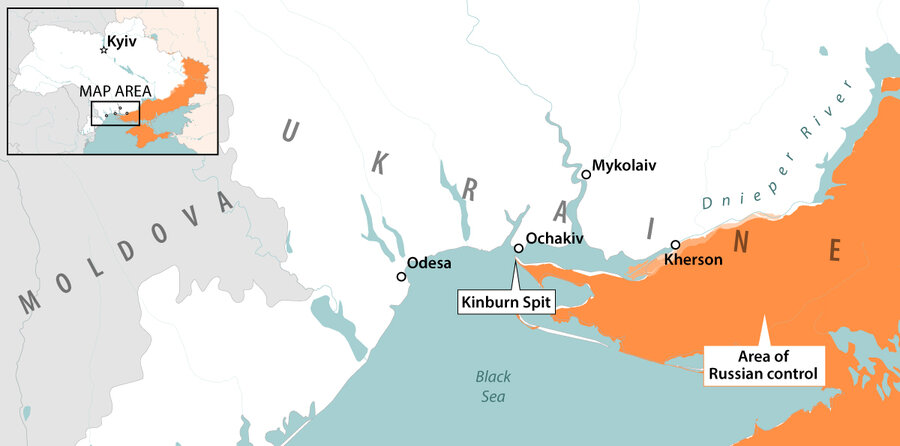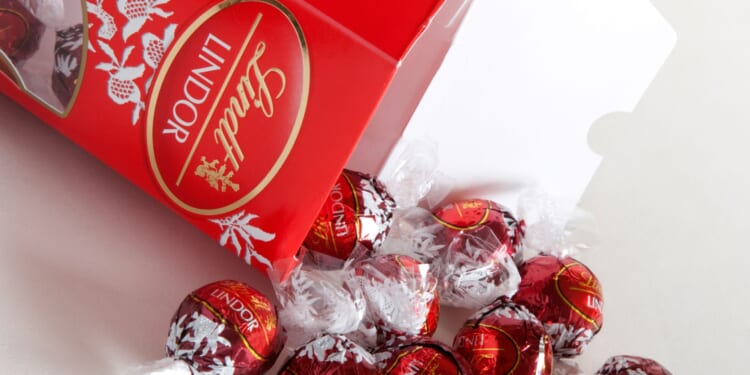As mayor and head of the military administration of the Dnieper-Bug Estuary port of Ochakiv, Sergii Bychkov knows what the Turkish beys and Catherine the Great of Russia knew before him about the Kinburn Spit.
Whoever controls that long and narrow peninsula just opposite Ochakiv controls the economy and prosperity of southern Ukraine, from the inland port cities of Kherson and Mykolaiv westward to the Black Sea port of Odesa.
And even beyond.
Why We Wrote This
Russia’s military presence on a narrow sandbar controlling a major Black Sea access point has badly disrupted Ukraine’s economy. What can Kyiv do about that?
“It is hard to overstate the strategic importance of the piece of land that we see out there every day,” says Mr. Bychkov, gesturing from his office toward the sandbar some 2 miles off Ochakiv’s shores.
“But with the Russians in control, they control the economic activity,” he says. “With the Kinburn Spit in their hands, everything is blocked.”
That “everything” ranges from shipbuilding in Mykolaiv, a historic dockyard for Imperial Russia and then the Soviet Union, to agricultural exports out of Ochakiv, a key link in Black Sea security and trade routes even before the Ottoman Empire.
Moreover, the spit holds the key to the Dnieper River – Ukraine’s equivalent of the Mississippi as a national central artery of trade and commerce.
The Kinburn Spit – “kinburn” derives from the Turkish words for “hair” and “cape,” thus describing a cape of land as long and thin as a hair – fell to the Russians in June 2022, four months into Moscow’s full-scale invasion of Ukraine.
Since then, Russian troops have used the spit and the entire peninsula (which carries the same name) to launch near-daily attacks on Ochakiv, missile and drone strikes deeper into Ukraine, and extensive waterway mining operations that have left the once-bustling artery unusable.
“Just by looking at the map you can understand the critical importance of this small strip of land,” says Anastasiia Khmel, dean of the faculty of political sciences at Black Sea National University in Mykolaiv. “Its role as a gateway to ports and distant regions explains why powers have fought for centuries to control it.”
And why Ukraine and Russia still do.
As important as Crimea?
Indeed, the spit’s strategic importance to Ukraine’s economic future explains why earlier this year, Trump administration officials promoted a ceasefire deal by which the Kinburn Spit and peninsula would return to Ukrainian sovereignty in exchange for major territorial concessions – including Crimea – to Russia.
“I think the major issues here [include] how the Ukrainians are able to use the Dnieper River and get out to the ocean,” President Donald Trump’s special envoy Steve Witkoff said in a May 13 interview with Breitbart News. In April, Mr. Witkoff had discussed the idea of a territorial sovereignty accord with Ukrainian officials in anticipation of ceasefire negotiations with Russia.
The Ukrainians’ top priority is to regain control of the waterway off Ochakiv and to revive the commerce that has long fueled the region’s growth.
But as the reality of a stalemated war has sunk in, and prospects for retaking all the territory that Russia has occupied have dimmed, some are also proceeding with a Plan B that would build the region’s future on the foundations of natural and human resources that are still in Ukrainian hands.
Behind that realist thinking are the three years that Russia has maintained its stranglehold on critical shipping routes – and an understanding of why Russian President Vladimir Putin is unlikely to relinquish that control easily.
“With the Kinburn Spit and peninsula in Ukrainian hands, our idle ports could be exporting the region’s products, and of course they could import arms,” Dr. Khmel says.
Moscow knows that “the battleships of the Soviet navy were built in Mykolaiv, and that potentially Ukraine could build its navy here as well. All of that,” she adds, “is incentive for Russia not to give up its control.”
Using what they’ve got
In Mykolaiv, Plan B focuses on the water resources that are accessible now.
“We are a water-oriented people, we have the water in our DNA, we have been building ships here since the time of the Cossacks,” says Artem Vashchilenko, coordinator of the Mykolaiv business community plan to rebuild and diversify the city’s economy.
With assistance from a European Union program encouraging development of a “blue economy,” the Dnieper River port city plans to use its waterfront for residential and water sports projects and focus economic renewal plans on water-oriented businesses.
Mykolaiv’s population dropped from 500,000 before the war to less than half that at the height of Russia’s siege of the city in 2022. But since then, the population has rebounded to about 390,000, including many Ukrainians displaced from Russian-occupied territories to the east and south.
The construction of large ships is likely to stay on hold indefinitely, given Russia’s chokehold on the estuary, but Mr. Vashchilenko says the construction of small boats and yachts has continued and even started to grow recently.
At Mykolaiv’s Admiral Makarov National University of Shipbuilding, the order of the day is innovation, prompted by the war.
“We already understood that our university as it was before the war would never come back, so we set out early on to find a new model,” says university rector Mikhailo Mikhailov.
The war, he says, has opened up new avenues of research and development, “as military activity has throughout history.”
The university is expanding programs in industrial robotics and drone technology – especially sea drone innovation, a recent Ukrainian strong suit.
Many of the university’s educational activities are now online, in part as a result of Russian strikes on the campus. But the international student population has grown – notably with the arrival of Chinese students – while the university maintains links with Denmark and with French and German shipbuilding companies.
Another victim of Russia’s occupation of the Kinburn Spit is Nibulon Ltd., one of Ukraine’s top grain producers and exporters.
“Our founder visited the Mississippi, and then he built 15 river terminals and 27 grain storage silos in Ukraine,” says Mikhailo Ryzak, Nibulon’s director of international cooperation. “But right now the Mykolaiv river shipping operations are pretty quiet.”
Brighter prospects in sight
Before 2022, Nibulon was shipping 5 million metric tons of grain a year through the Black Sea and on to a hungry world – some of it in conjunction with the United Nations World Food Program.
The war changed that.
More than 100 vessels, from private yachts to cargo ships, were stranded in Mykolaiv, where they remain. Nibulon has had to convert its Mykolaiv operations to dry port shipping, transporting grain overland at much higher cost.
About 80% of Nibulon’s Mykolaiv facilities sit unused.
Still, Mr. Ryzak sees some glimmers promising positive steps in the future.
The prisoner exchanges that Ukraine and Russia have agreed to over the past year, for example, could serve as a template for safe passage for those 100 trapped vessels to the Black Sea, he says.
That could open the way to demining and reopening the estuary.
Ukrainian entities, including shipping companies like Nibulon, are also working with European partners to develop a Danube River alternative to shipping via the Black Sea.
“There’s hope”, says Mr. Ryzak, “that with the help of our partners … some trust can be built in order to revive economic activity” in the Dnieper River region.
Oleksandr Naselenko assisted in reporting this story.















